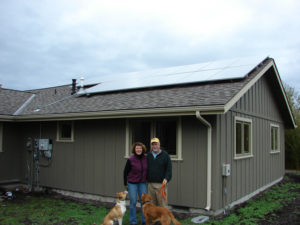Steps to Grid Tie Solar
Steps to Grid Tie Solar
Interested in going solar but not sure about the process? The good news is going solar is simple and easy, because we assist you every step of the way. This guide outlines what information we need from you and what to expect from the beginning to after your installation is complete.
1) Gather Initial Information
- Do you have a sunny south-facing roof or a field with space for a group mount solar system?
- Want solar panels on your roof? Will your roof last another 15 years or does it need to be replaced in the next few years?
- Do you owe enough federal taxes to take a 30% federal tax credit over the next few years? (Consult your tax advisor.)
- How much electricity do you use per year in kilowatt hours. This information is available from your utility bills or by calling your electricity provider.
- Whose name is on your utility account?
- How much do you want to invest in solar panels for your home?
2) Contact FMS
Once you have this information, contact FMS to discuss:
- Site conditions.
- Annual power use in kilowatt hours.
- Amount of power you want to offset.
- How much you want to invest in solar.
- Available incentives for solar.
- Financing options.
- Additional questions.
3) Review Your Preliminary Proposal
Because of the many tools available that allow us to gather important details about your home or business remotely, we are often able to prepare a preliminary proposal without visiting your property. Doing this allows you to get a realistic idea of how much solar can be put on your home, and how much that will cost, more quickly. It also reduces our operating expenses, which means you save money on your solar system.
When you receive your preliminary proposal we will answer all your questions about the recommended solar design and the cost.

You will then be able to:
- Schedule a site survey (if necessary) and receive a finalized proposal.
- Sign the agreement and submit your down payment.
- If desired, apply for a solar loan through Puget Sound Cooperative Credit Union (PSCCU) or another one of the many solar lenders in Washington.
4) Solar Site Assessment
Depending on a number of factors, we may schedule a solar site survey before preparing your proposal, or after receiving initial acceptance of our contract. During the assessment we may:
- Calculate shade and solar exposure (solar resource).
- Measure roof space or examine your preferred location for a ground mount solar system.
- Inspect your electrical breaker panel(s).
- Design a site plan.
If the site survey is performed after acceptance of our contract and reveals any information that alters the solar system design or contract pricing, we will present you with a revised contract to consider.
5) Then leave the rest to FMS. We will:
- Fill out the required Interconnection Agreement for your utility, ready for you to sign.
- Obtain all necessary permits for your project.
- Order all the equipment and materials needed for your solar installation.
6) We will contact you to schedule the installation for dates that best fit your schedule.
- Installation of a residential rooftop solar system generally takes two to three days to complete. Commercial and ground mounted solar installations may take longer.
- When your solar system installation is complete we will call fo an electrical inspection, which typically happens the following day. The electrical inspector will confirm the system has been installed correctly and is safe for use.
- We will then notify your utility provider that your home is ready to have the new meter installed that tracks the amount of solar you send out to the grid for credits on your bill (READ ABOUT: Net Metering).
7) Your System is Now Operational.
Congratulations! Your new solar power system is generating power from the sun.
- After your installation is complete and your utility has installed your new net meter we will walk you through your system’s operation.
- If your system includes online monitoring, we will set up your monitor and connect it to the internet connection you provide. We will also provide you with the information you need to view your system’s production and status via the internet.
- We will provide you with an owner’s manual that includes specification sheets for the major pieces of equipment, warranty information, and even a guide on how to read your meter.
Net Metering
Your utility provider will read your meters every month, and because your system will be offsetting an amount of your usual power use, you will see an immediate reduction in your electric bill.
Each utility bill will document your net meter reading (the excess power you produced and sent back to the grid) so you can see your solar credits. You will also be able to look at your net meter to see which direction the electricity is flowing in real time.
But remember, the net meter only records excess power sent to the grid. It does not record the electricity generated by your solar system that was used in your home by your devices. READ: Net Metering
Federal Solar Income Tax Credit (ITC): Rates and How to Use
The Solar ITC is 30% for the entire cost of equipment and labor to install solar electric systems through 2032. If you have a grid hybrid solar system that includes energy storage batteries for use during power outages, the cost for the batteries and installation is also eligible for the 30% tax credit.
To take the tax credit you will need copies of all of your paid invoices to show the total cost for installation. File IRS form 5695, Residential Energy Credits, with your federal taxes. For more information on claiming the Solar ITC, please consult with the IRS or your tax professional.
Additional Information
- Remember to add your solar power system to your homeowner’s insurance policy if it is required by your carrier.
- Wash your solar panels seasonally if you notice dust, pollen or bird dropping on them. This will allow your panels to continue producing the most electricity possible, giving you the best return on your investment.
- It’s a best practice to check your systems operation monthly to confirm it is operating. In the unlikely event there is any interruption in sysem operation, you will catch it quickly and ensure you are receiving the maximum electrical production from your solar.


